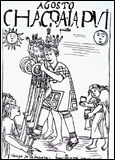
Collective labor, planting seeds, from Guaman Poma, El primero nueva cor≤nica y buen gobierno, Rolena Adorno and John Murra edition, Siglo Veintiuno Editores, Mexico City.
 ndean states coordinated diverse communities spread out like islands over different ecological zones. The coordination of these environments produced great wealth but also presented challenges. It was difficult to create long-lasting stability. Empires rose and fell. Political institutions at the state level used ancient principles of community organization based on kinship collectives. These collectives, called ayllu, traced their roots to a common ancestor and were the most basic social unit of Andean society. Ayllus organized labor on a reciprocal basis in order to work land that was held in common but divided into family parcels. Villages and towns were comprised of several ayllus. Each ayllu also farmed a portion of its land for the state and contributed workers for state projects. The labor of many therefore resulted in magnificent wealth for the elite. In return, the state provided public works, performed important religious functions, and provided protection from famine through an extensive food storage system.
ndean states coordinated diverse communities spread out like islands over different ecological zones. The coordination of these environments produced great wealth but also presented challenges. It was difficult to create long-lasting stability. Empires rose and fell. Political institutions at the state level used ancient principles of community organization based on kinship collectives. These collectives, called ayllu, traced their roots to a common ancestor and were the most basic social unit of Andean society. Ayllus organized labor on a reciprocal basis in order to work land that was held in common but divided into family parcels. Villages and towns were comprised of several ayllus. Each ayllu also farmed a portion of its land for the state and contributed workers for state projects. The labor of many therefore resulted in magnificent wealth for the elite. In return, the state provided public works, performed important religious functions, and provided protection from famine through an extensive food storage system.